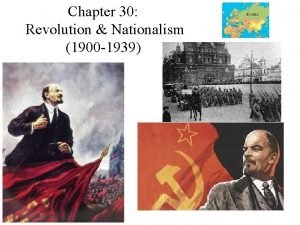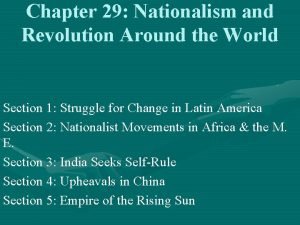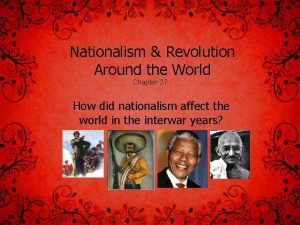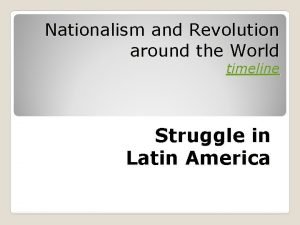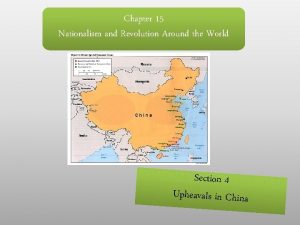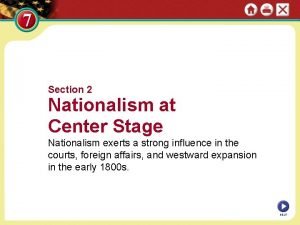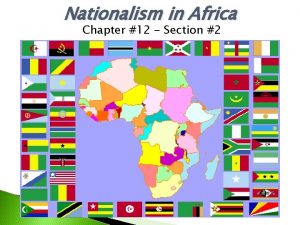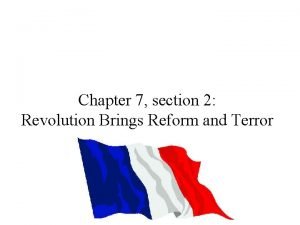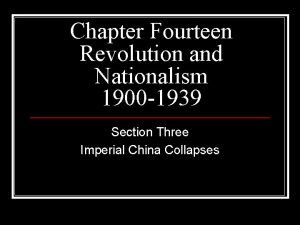Chapter 14 Revolution and Nationalism 1900 1939 Section









- Slides: 9

Chapter 14 – Revolution and Nationalism (1900 – 1939) Section 3 – Imperial China Collapses Main Idea: After the fall of the Qing dynasty, nationalist and Communist movements struggled for power Why It Matters Now: The seeds of China’s late-20 th-century political thought, communism, were planted at this time

What was happening in China when we last visited there?

Nationalists Overthrow Qing Dynasty • Kuomintang (Nationalist Party)- is led by Sun Yixian – Pushed for modernization and nationalization – 1911, Revolutionary Alliance takes out the Qing dynasty (ruled since 1644) – Sun named president of new Republic of China • Three Principles of People: ① Nationalism ② People’s rights ③ People’s livelihood Taiwan's $100 Bill

Sun loses power • Sun has no military support • General Yuan Shikai took over – He went against democracy – This started revolts of the people – General died sparking revolution • Power turned over to warlords

China in WWI • China supported Allies hoping for Germany to return their land – Allies give Japan the land, however • May 4, 1919 - the MAY FOURTH MOVEMENT • 3, 000 students protested in Beijing over Treaty § Spread to other areas and exploded into national movement §New thinkers wanted Soviet communism

Communist Party in China • 1921, Mao Zedong and others found the communist party in China • Mao thought of revolution of the peasant country folk • Jiang Jieshi (formerly Chiang Kai-shek) took over Kuomintang and went against communists – Govt went corrupt – Mao gave land to the people so they sided with him • 1927 - Jiang had communist leaders killed and took complete power – Became president of Nationalist Republic of China in 1928

Civil War Rages in China • In 1930, Mao took communist armies to the south-central area of China avoiding defeat • 1933: Jiang’s army of 700, 000 surrounded Mao’s 100, 000 men in the mountains – Communist forces retreated on a 6, 000 -mile-long hike. The LONG MARCH killed thousands of communist red army fighters but saved the group – During this MARCH, Japan invaded China in 1937 • Bombed villages and cities • By 1938, Japan controls much of China • Invasion forces two groups to stop civil war and fight Japan

Red Army soldiers marching part of the 6, 000 miles Luding Bridge

Red Army troops crossing the snowy mountains Mao on the Long March Cave dwellings in Shaanxi Communist leader addresses the survivors of the Long March
 Revolutionary leaders 1900-1939
Revolutionary leaders 1900-1939 Russian revolution vocabulary
Russian revolution vocabulary Chapter 29 nationalism around the world answers
Chapter 29 nationalism around the world answers When did mao take over china
When did mao take over china Nationalism and revolution around the world
Nationalism and revolution around the world Nationalism and revolution around the world
Nationalism and revolution around the world Chapter 7 section 2 nationalism at center stage
Chapter 7 section 2 nationalism at center stage Chapter 12 section 2 answer key
Chapter 12 section 2 answer key How did the gibbons v ogden decision promote nationalism
How did the gibbons v ogden decision promote nationalism Chapter 7 section 2 revolution brings reform and terror
Chapter 7 section 2 revolution brings reform and terror

